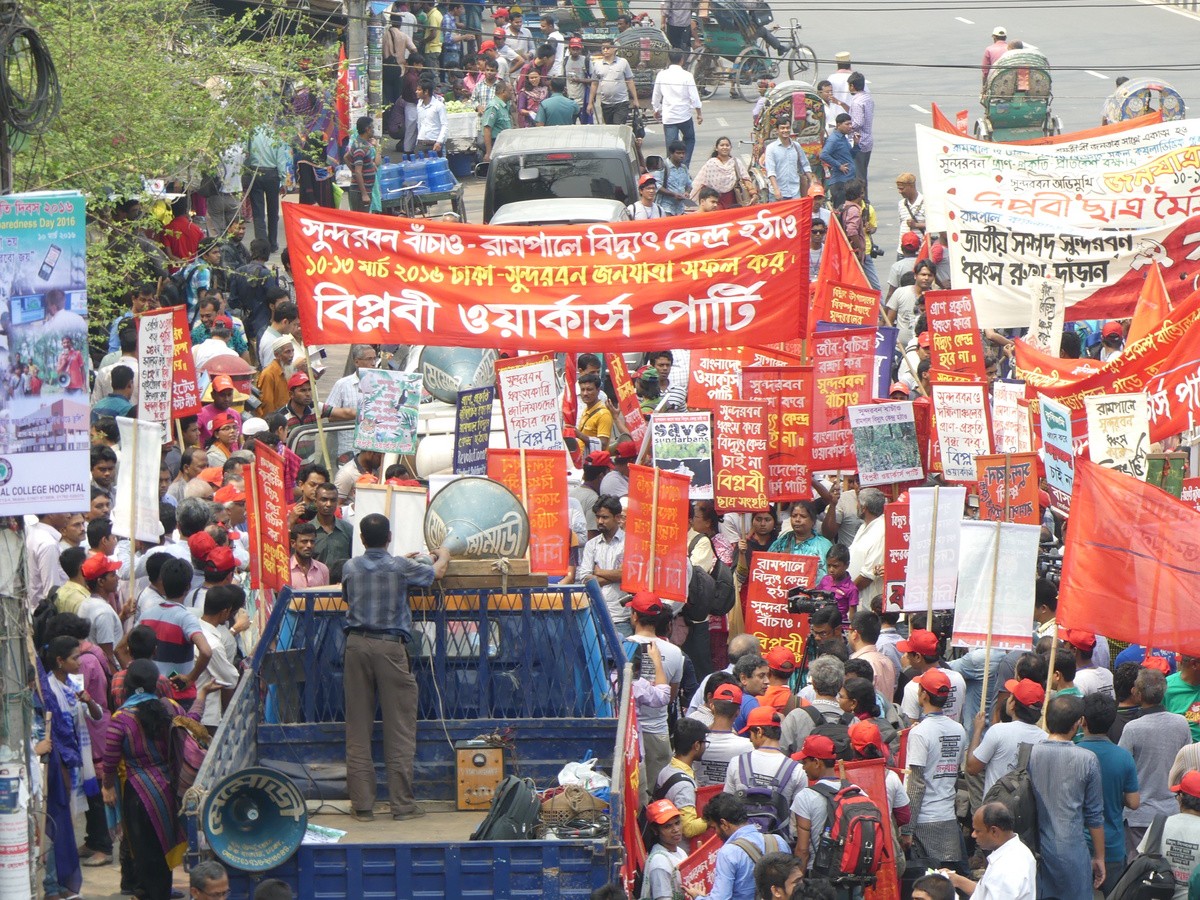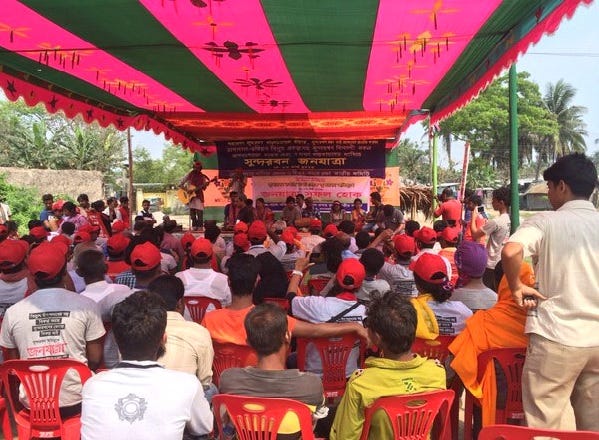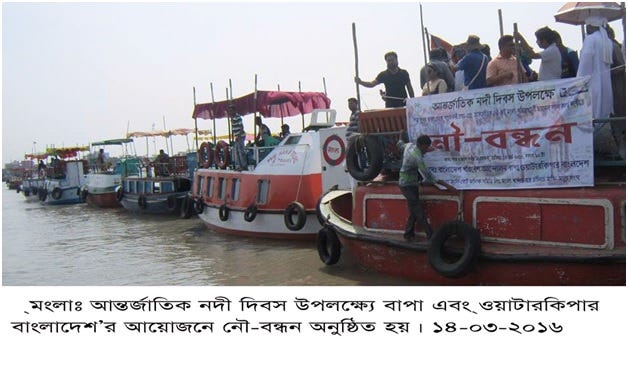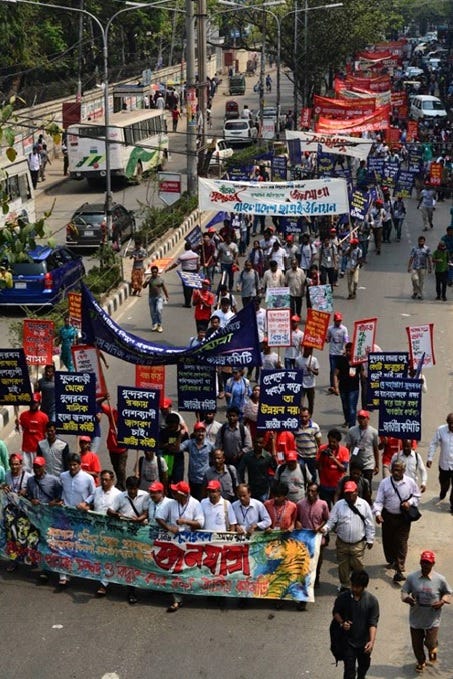- Blog
- Sustainable Economic Systems
- International Sustainable Finance
- Thousands in Bangladesh march across 155 miles against threatening coal projects
Thousands in Bangladesh march across 155 miles against threatening coal projects
by Jenny Bock, Economic Justice Campaigner

Donate Now!
Your contribution will benefit Friends of the Earth.
Stay Informed
Thanks for your interest in Friends of the Earth. You can find information about us and get in touch the following ways:
Thousands of Bangladeshis participated in a “Long March” from the capital city of Dhaka to the Sundarbans forest March 10 to March 13 to protest the construction of various coal projects proposed for Bangladesh. They sent a strong message of opposition to local industry and government officials as well as international decision-makers. During this four-day, 155-mile-long demonstration, protesters had one demand: “Save the Sundarbans!” The Sundarbans forest, a UNESCO World Heritage Site that is located on the border of Bangladesh and India, is the world’s largest mangrove forest and is under threat of being harmed by two massive coal projects, one of which the U.S. Export-Import Bank is rumored to be considering financing.
Proposed to be built approximately 8.7 miles from the Sundarbans mangrove forest, the Rampal coal plant and Orion Group’s Khulna coal plant pose severe threats to not only the forest’s mangrove ecosystem and precious wildlife but also to thousands of indigenous communities who have been living in the Sundarbans for centuries. In addition, Orion Group says its Orion-Power Dhaka coal plant, which is proposed to be built near the capital city Dhaka, is being implemented with financing participation from U.S. Ex-Im Bank. While it’s important to note the Orion-Dhaka coal project would be located approximately 156 miles north of the Sundarbans, communities are equally as concerned about the health and environmental risks the project poses due to it’s close proximity to Dhaka — Bangladesh’s largest city — such as the threat of coal ash and other air toxins being exposed to the 17 million people that live in the Dhaka area.
Bangladeshi communities have been protesting these coal projects since 2001. Building upon the momentum of the first Sundarbans Long March in 2013 which was captured in the inspiring documentary Long Live Sundarbans, this year’s march shows that opposition to the Rampal and Orion coal projects is gaining momentum. This growing public opposition is the result of environmental advocacy groups, farming, fishing and indigenous communities working together over a series of many years to raise public awareness about the negative social and environmental threats associated with the coal projects. Since the first Long March protest three years ago, construction for the Rampal coal power plant has begun with one site already fully operating. Anticipating that the construction process for the Rampal and Orion coal projects may accelerate this year, thousands of people took to the streets two weeks ago to demand these projects be stopped.


Marchers began their journey in the capital Dhaka and held rallies along the way before arriving in Khulna where the Rampal plant and Orion-Khulna coal projects are proposed to be built. People collectively chanted throughout the protests, “Long March! Long March! Long March” preserving the tradition that started during the first march. Several rallies were also held along the 155-mile long journey from Dhaka to the Sundarbans. In the Passur River, hundreds of fishing boats formed a chain to protest the coal projects which fishing communities fear will contaminate rivers like the Passur that run through the Sundarbans forest. In the Bagherhat district, activists held a colorful rally that included protesters performing a resistance song.
Bangladeshi activists and local communities are opposed to these coal projects for numerous reasons. Firstly, people are concerned about the negative social impacts these projects would have and are already having on local communities. According to a report published by human rights group, South Asians For Human Rights, the projects pose several threats to people’s livelihood. During the land acquisition process in which land was bought for the Rampal coal project and local communities were forced to relocate, due process was not followed. Affected communities were given no advanced notice about the project nor consulted about what kind of compensation they would receive from the government for relocating. Compensation to local land owners has been insufficient. Some families received a piece of land smaller than the land they originally owned. A large number of families whose livelihood depends on the land and local water sources to do subsistence farming and fishing have been displaced with no compensation at all. Failing to properly consult communities in the development process is unfortunately a common problem. In addition, similarly to other deadly coal projects the U.S. Ex-Im Bank has financed, according to SAHR’s report, local communities and activists protesting the Rampal and Orion Group’s Khulna project have also been harassed by authorities through threats and assaults.
On top of the land rights and human rights issues associated with these coal projects, the environmental risks associated with the Rampal coal plant and Orion Group’s coal projects also pose great harm to local communities’ livelihood. Communities and activists have expressed major concerns about air and water pollution. According to SAHR’s report, if these coal projects are built, environmental advocates predict there will be extensive air and water pollution due to the toxins that seep into local water sources during the construction process and the inevitable coal and oil spills that will occur in the process of about 400 ships transporting coal to be burned for power in Bangladesh through the Sundarbans’ Passur and Maidara rivers each year. Just this past Saturday, March 19, a cargo vessel carrying 1,235 tonnes of coal used for brick-kilns capsized in Shela River, a river located in the Chandpai region of the Sundarbans forest. Furthermore, an oil tanker boat that capsized in Shela River on December 9, 2014 caused severe damage to the ecosystem of the Sundarbans forest. As a country that relies heavily on agricultural production, people are also concerned letting industry into the Sundarbans will open up the flood gates for more companies to come in and pollute agricultural land further south of the area. Furthermore, people are concerned about the projects’ impacts on climate change and Bangladesh’s ability to combat the effects of climate change the country is already experiencing. A bustling eco-system, the Sundarbans support the livelihoods of several million people. The mangrove forest acts as a buffer zone and protects the shorelines of both Bangladesh and India from storm surges and flooding. In addition to the construction of these coal projects increasing the Sundarbans’ already high vulnerability to sea-level rise, the process of burning more coal would only worsen the effects of climate change.

The Long March is an amazing and inspirational example of how communities across the world are taking on the task of protecting people and the planet into their own hands and are showing that people have the power to create the world they want to see. And we are seeing the valiant efforts of Bangladesh communities are starting to have an impact. Various U.S environmental groups shared updates of the protests on social media and several news outlets including Think Progress, Al Jazeera and the Guardiancovered the protests. Bangladeshi groups are asking the international community for support to save the Sundarbans. Standing in solidarity with the thousands of Bangladeshis who oppose these projects along with six other U.S. groups, we urge the U.S. Ex-Im Bank to publicly commit to rejecting any proposal for Ex-Im Bank financing for harmful industrial projects near the Sundarbans and other harmful fossil fuel projects in Bangladesh. Bangladesh, one of the nations most vulnerable to climate change, deserves a better energy solution.
